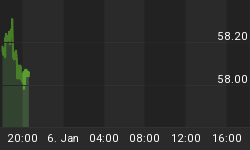The debt binge since 1975, fueled by an easy-money policy from the Fed, has landed the US economy in serious difficulties. Wall Street no doubt lobbied hard for debt expansion, because of the boost to interest margins, with little thought as to their own vulnerability. There can be no justification for debt to expand at a faster rate than GDP -- a rising Debt to GDP ratio -- as this feeds through into the money supply, causing asset (real estate and stocks) and/or consumer prices to balloon. What we see here is clear evidence of financial mismanagement of the US economy over several decades: the graph of debt to GDP should be a flat line.

The difference between domestic and private (non-financial) debt is public debt, comprising federal, state and municipal borrowings. When we look at aggregate debt below, domestic (non-financial) debt is still rising, albeit at a slower pace than the 8.2 percent average of the previous 5 years (2004 to 2008). Public debt is ballooning in an attempt to mitigate the deflationary effect of a private debt contraction. Clearly this is an unsustainable path.

The economy has grown addicted to debt and any attempt to go "cold turkey" -- cutting off further debt expansion -- will cause pain. But there are steps that can be taken to alleviate this.

If private debt contracts, you need to expand public debt -- by running a deficit -- in order to counteract the deflationary effect of the contraction. The present path expands public debt rapidly in an attempt to not only offset the shrinkage in private debt levels but also to continue the expansion of overall (domestic non-financial) debt levels. This is short-sighted. You can't borrow your way out of trouble. And encouraging the private sector to take on more debt would be asking for a repeat of the GFC. The private sector needs to deleverage but how can this be done without causing a total economic collapse? The answer lies in government spending.
Treasury cannot afford to borrow more money if this is used to meet normal government expenditure. Public debt as a percentage of GDP would sky-rocket, further destabilizing the economy. If the proceeds are invested in infrastructure projects, however, that earn a market-related return on investment -- whether they be high-speed rail, toll roads or bridges, automated port facilities, airport upgrades, national broadband networks or oil pipelines -- there are at least four benefits. First is the boost to employment during the construction phase, not only on the project itself but in related industries that supply equipment and materials. Second is the saving in unemployment benefits as employment is lifted. Third, the fiscal balance sheet is strengthened by addition of saleable, income-producing assets, reducing the net public debt. Lastly, and most importantly, GDP is boosted by revenues from the completed project -- lowering the public debt to GDP ratio.
Public debt would still rise, and bond market funding in the current climate may not be reliable. But this is the one time that Treasury purchases (QE) by the Fed would not cause inflation. Simply because the inflationary effect of asset purchases are offset by the deflationary effect of private debt contraction. Overall (domestic non-financial) debt levels do not rise, so there is no upward pressure on prices.
Infrastructure investment should not be seen as the silver bullet, that will solve all our problems. Over-investment in infrastructure can produce diminishing marginal returns -- as in bridges to nowhere -- and government projects are prone to political interference, cost overruns, and mismanagement. But these negatives can be minimized through partnership with the private sector.
Projects should also not be viewed as a short-term, band-aid solution. The private sector would have to increase hiring and make substantial capital investment in order to support these projects. All the good work would be undone if the spigot is shut off prematurely. What is needed is a 10 to 20 year program to revamp the national infrastructure, restore competitiveness and lay the foundation for future growth.
There are no quick fixes. But what the public needs is a clear path to recovery, rather than the current climate of indecision.
















